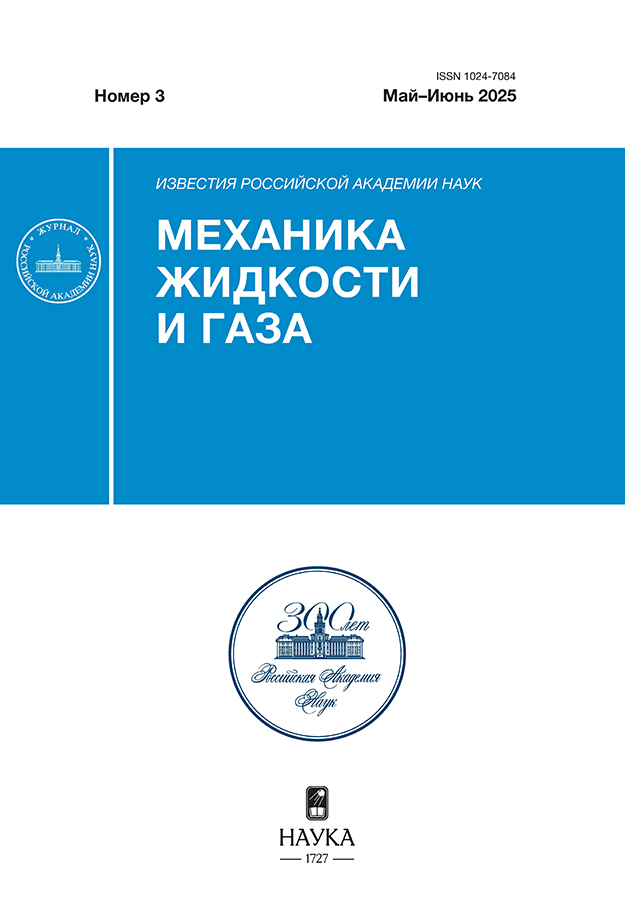Mathematical Modeling of the Effect of Cell Mobility and Active Intercellular Interactions on the Sorting of the Cells of Two Types in the Cultures of Biological Tissues
- Authors: Logvenkov S.A.1,2
-
Affiliations:
- National Research University “Higher School of Economics,”
- Moscow State University, Institute of Mechanics
- Issue: No 2 (2023)
- Pages: 9-19
- Section: Articles
- URL: https://journals.rcsi.science/1024-7084/article/view/135061
- DOI: https://doi.org/10.31857/S0568528122600813
- EDN: https://elibrary.ru/NTKIEV
- ID: 135061
Cite item
Full Text
Abstract
The cell motion is at the bottom of many biological phenomena. An important role in controlling cell motions is played by active stresses developing in biological tissues as a result of mechanical intercellular interactions. An investigation of the evolution of the mixtures of cells of different types forming cell aggregates shows that active intercellular force interactions lead to the spatial separation of the cells of different types, or the cell sorting. Within the framework of the continuum model of biological media [24] (the cells of different types are regarded as separate phases), in this study we investigate the effect of the parameters characterizing various mechanisms of the development of
active intercellular stresses, as well as adhesion and cell mobility, on the process of the sorting of cells of two types that form an aggregate of spherical shape at the initial moment of time. It is shown that the sufficient condition for the sorting of cells of different types and the formation of a sharp boundary between the regions occupied by these cells is the absence of contracting interactions between the cells of different phases under the condition of asymmetry of the initial distributions of their concentrations or asymmetry of the parameters characterizing the development of active stresses in different phases. It is shown that the cells of the phase, where active contracting intercellular interactions are stronger (at the same values of the other parameters and the same initial distributions of phase concentrations for different cell phases), strive to occupy the central region of a spheroid. At the same time, the cells of the other phase, where the contracting interactions are weaker, are displaced to the periphery. An increase in the parameter characterizing cell repulsion leads to the displacement of this cell phase toward the periphery. Beside the active interaction forces, the cell motions can be controlled by both passive mechanical properties of the medium and the cell mobility. The asymmetry of the interphase distributions of these parameters can lead to the situation, when the cells that possess the greater contracting interactions will be displaced toward the cell spheroid periphery and surround the cells, the interaction between which is weaker
Keywords
About the authors
S. A. Logvenkov
National Research University “Higher School of Economics,”; Moscow State University, Institute of Mechanics
Author for correspondence.
Email: logv@bk.ru
Moscow, 101000 Russia; Moscow, 101000 Russia
References
- Davidson L.A., Joshi S.D., Kim H.Y., Dassow M., Zhang L., Zhou J. Emergent morphogenesis: elastic mechanics of a self-deforming tissue // J. Biomech. 2010. V. 43. № 1. P. 63–70.
- Keller R., Davidson L., Edlund A., Elul T., Ezin M., Shook D., Skoglund P. Mechanisms of convergence and extension by cell intercalation // Philos. Trans. R. Soc. Lond. B Biol. Sci. 2000. V. 355 (1399). P. 897–922.
- Keller R., Davidson L.A., Shook D.R. How we are shaped: The biomechanics of gastrulation // Differentiation. 2003. V. 71. P. 171–205.
- Fried P., Gilmour D. Collective cell migration in morphogenesis, regeneration and cancer // Nat. Rev. Mol. Cell Biol. 2009. V. 10. P. 445–457.
- Farooqui R., Fenteany G. Multiple rows of cells behind an epithelial wound edge extend cryptic lamellipodia to collectively drive cell-sheet movement // J. Cell. Sci. 2005. V. 118. P. 51–63.
- Serra-Picamal X., Conte V., Vincent R., Anon E., Tambe D.T., Bazellieres E., Butler J.P., Fredberg J.J., Trepat X. Mechanical waves during tissue expansion // Nature Physic. 2012. V. 8. P. 628–634.
- Tracqui P. Biophysical models of tumour growth // Rep. Progr. Phys. 2009. V. 72. № 5. P. 056701.
- Franssen L.C., Lorenzi T., Burgess A.E.F., Chaplian M. A. J. A mathematical framework for modelling the metastatic spread of cancer // Bull. Math. Biol. 2019. V. 81. P. 1965–2010.
- Mammoto T., Ingber D.E. Mechanical control of tissue and organ development // Development. 2010. V. 137. № 9. P. 1407–1420.
- Reig G., Pulgar E., Concha M.L. Cell migration: from tissue culture to embryos // Development. 2014. V. 141. № 10. P. 1999–2013.
- Gerhart J.C. Mechanisms regulating pattern formation in the amphibian egg and early embryo. In: “Biological Regulation and Development, Goldberger R. (ed), New York: Plenum Press, 1980. V. 2. P. 133–316.
- Beloussov L.V., Louchinskaia N.N., Stein A.A. Tension-dependent collective movements in the early gastrula ectoderm of Xenopus laevis embryos // Dev. Gen. Evol. 2000. V. 210. P. 92–104.
- Maitre J.L., Berthoumieux H., Krens S.F., Salbreux G., Julicher F., Paluch E., Heisenberg C.P. Adhesion functions in cell sorting by mechanically coupling the cortices of adhering cells // Science. 2012. V. 338(6104). P. 253–256.
- Theveneau E., Mayor R. Cadherins in collective cell migration of mesenchymal cells // Curr. Opin. Cell Biol. 2012. V. 24. P. 677–684.
- Pawlizak S., Fritsch A.W., Grosser S., Ahrens D., Thalheim T., Riedel S., Kiebling T.R., Oswald L., Zink M., Manning M.E., Kas J. A. Testing the differential adhesion hypothesis across the epithelial-mesenchymal transition // New Journal of Physics. 2015. V. 17. № 8. 083049.
- Vasioukhin V., Fuchs E. Actin dynamics and cell-cell adhesion in epithelia // Curr. Opin. Cell Biol. 2001. V. 13. № 1. P. 76–84.
- Bertet C., Sulak L., Lecuit T. Myosin-dependent junction remodelling controls planar cell intercalation and axis elongation // Nature. 2004. V. 429. P. 667–671.
- Lecuit T., Lenne P.F., Munro E. Force generation, transmission, and integration during cell and tissue morphogenesis // Annu. Rev. Cell Dev. Biol. 2011. V. 27. P. 157–184.
- Harris A.K. Is cell sorting caused by differences in the work of intercellular adhesion? A critique of the steinberg hypothesis // J. Theor. Biol. 1976. V. 61. P. 267–285.
- Brodland G.W. The Differential Interfacial Tension Hypothesis (DITH): a comprehensive theory for the self-rearrangement of embryonic cells and tissues // J. Biomech. Eng. 2002. V. 124. P. 188–197.
- Krieg M., Arboleda-Estudillo Y., Puech P.H., Kafer J., Graner F., Muller D.J., Ytisenberg C.-P. Tensile forces govern germ-layer organization in zebrafish // Nat. Cell Biol. 2008. V. 10. P. 429–436.
- Steinberg M.S., Wiseman L.L. Do morphogenetic tissue rearrangements require active cell movements? // J. Cell Biol. 1972. V. 55. P. 606–615.
- Mehes E., Viscek T. Segregation mechanisms of tissue cells: from experimental data to models // Complex Adapt. Syst. Model. 2013. V. 1. P. 4.
- Логвенков С.А., Штейн А.А. Континуальное моделирование биологической среды, составленной активно взаимодействующими клетками двух разных типов // Изв. РАН. МЖГ. 2020. № 6. С. 3–16.
- Логвенков С.А., Штейн А.А. Континуальное моделирование сортировки клеток в плоском слое с учетом возможного расхождения границ областей, занятых клетками двух разных типов // Изв. РАН. МЖГ. 2022. № 3. С. 1–16.
- Логвенков С.А. Моделирование сортировки двух типов клеток в клеточном сфероиде с учетом подвижности границ областей, занятых клетками разных типов // Изв. РАН. МЖГ. 2022. № 6. С. 101–115.
- Stein A.A., Logvenkov S.A., Volodyaev I.V. Continuum modeling of mechano-dependent reactions in tissues composed of mechanically active cells // BioSystems. 2018. V. 173. P. 225–234.
- Белоусов Л.В., Логвенков С.А., Штейн А.А. Математическая модель активной биологической сплошной среды с учетом деформаций и переупаковки клеток // Известия РАН. МЖГ. 2015. № 1. С. 3–14.
- Логвенков С.А., Штейн А.А. Математическая модель пространственной самоорганизации в механически активной клеточной среде // Биофизика. 2017. Т. 62. № 6. С. 1123–1133.
- Taylor H.B., Khuong A., Wu Z., Xu Q., Morley R., Gregory L., Poliakov A., Taylor W.R., Wilkinson D.G. Cell segregation and border sharpening by Eph receptor-ephrin-mediated heterotypic repulsion // J. R. Soc. Interface. 2017. V. 14. № 132. P. 20170338.
- Canty L., Zarour E., Kashkooli L., François P., Fagotto F. Sorting at embryonic boundaries requires high heterotypic interfacial tension // Nat. Commun. 2017. V. 8. P. 157.
- Yanagida A., Corujo-Simon E., Revell C.K., Sahu P., Stirparo G.G., Aspalter I.M., Winkel A.K., Peters R., De Belly H., Cassani D.A.D., Achouri S., Blumenfeld R., Franze K., Hannezo E., Paluch E.K., Nichols J., Chalut K.J. Cell surface fluctuations regulate early embryonic lineage sorting // Cell. 2022. V. 185. № 5. P. 777–793.
- Mehes E., Viscek T. Collective motion of cells: from experiments to models // Integr. Biol. 2014. V. 6. № 9. P. 831–854.
- Halbleib J.M., Nelson W.J. Cadherins in development: cell adhesion, sorting, and tissue morphogenesis // Genes Dev. 2006. V. 20. P. 3199–214.
- Niessen C.M., Leckband D., Yap A.S. Tissue organization by cadherin adhesion molecules: dynamic molecular and cellular mechanisms of morphogenetic regulation // Physiol. Rev. 2011. V. 91. P. 691–731.
Supplementary files














